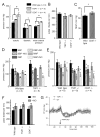Thrombospondin-1 and CD47 regulate blood pressure and cardiac responses to vasoactive stress
- PMID: 19284971
- PMCID: PMC2663008
- DOI: 10.1016/j.matbio.2009.01.002
Thrombospondin-1 and CD47 regulate blood pressure and cardiac responses to vasoactive stress
Abstract
Nitric oxide (NO) locally regulates vascular resistance and blood pressure by modulating blood vessel tone. Thrombospondin-1 signaling via its receptor CD47 locally limits the ability of NO to relax vascular smooth muscle cells and increase regional blood flow in ischemic tissues. To determine whether thrombospondin-1 plays a broader role in central cardiovascular physiology, we examined vasoactive stress responses in mice lacking thrombospondin-1 or CD47. Mice lacking thrombospondin-1 exhibit activity-associated increases in heart rate, central diastolic and mean arterial blood pressure and a constant decrease in pulse pressure. CD47-deficient mice have normal central pulse pressure but elevated resting peripheral blood pressure. Both null mice show exaggerated decreases in peripheral blood pressure and increased cardiac output and ejection fraction in response to NO. Autonomic blockade also induces exaggerated hypotensive responses in awake thrombospondin-1 null and CD47 null mice. Both null mice exhibit a greater hypotensive response to isoflurane, and autonomic blockage under isoflurane anesthesia leads to premature death of thrombospondin-1 null mice. Conversely, the hypertensive response to epinephrine is attenuated in thrombospondin-1 null mice. Thus, the matricellular protein thrombospondin-1 and its receptor CD47 serve as acute physiological regulators of blood pressure and exert a vasopressor activity to maintain global hemodynamics under stress.
Figures





References
-
- Bergseth G, Lappegard KT, Videm V, Mollnes TE. A novel enzyme immunoassay for plasma thrombospondin. Comparison with beta-thromboglobulin as platelet activation marker in vitro and in vivo. Thromb Res. 2000;99:41–50. - PubMed
-
- Chen D, Asahara T, Krasinski K, Witzenbichler B, Yang J, Magner M, Kearney M, Frazier WA, Isner JM, Andres V. Antibody blockade of thrombospondin accelerates reendothelialization and reduces neointima formation in balloon-injured rat carotid artery. Circulation. 1999;100:849–854. - PubMed
Publication types
MeSH terms
Substances
Grants and funding
LinkOut - more resources
Full Text Sources
Other Literature Sources
Molecular Biology Databases
Research Materials

